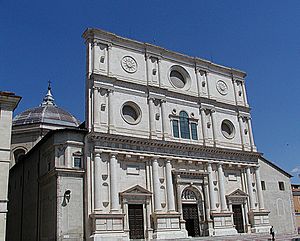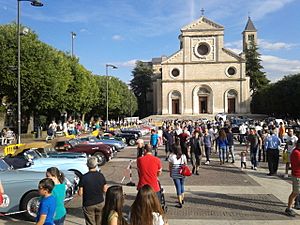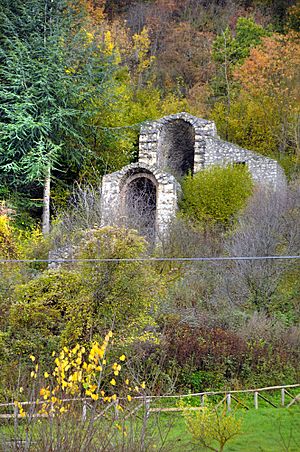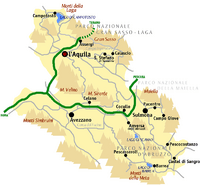Province of L'Aquila facts for kids
Quick facts for kids
Province of L'Aquila
L'Aquila
|
|
|---|---|
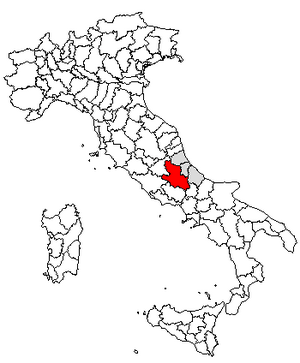 |
|
| Country | |
| Region | Abruzzo |
| Capital | L'Aquila |
| Area | |
| • Total | 5,034 km2 (1,944 sq mi) |
| Population
(2001)
|
|
| • Total | 297,592 |
| • Density | 59/km2 (150/sq mi) |
| Postal Code |
67100, 67010, 67012-67014, 67015, 67017, 67019-67064, 67066-67069
|
| Telephone prefix |
0862, 0863, 0864
|
| ISTAT | 066 |
| Vehicle registration | AQ |
| No. of communes | 108 |
The Province of L'Aquila (Italian: Provincia dell'Aquila) is a large and very mountainous area in the Abruzzo region of Southern Italy. It has fewer people living there compared to its size. This province covers about half of the Abruzzo region. It is located in the western part of Abruzzo.
L'Aquila province shares borders with several other provinces. To the north is Teramo. To the east are Pescara and Chieti. To the south is Isernia in the Molise region. To the west are Frosinone, Rome, and Rieti in the Lazio region. The main city and capital of the province is L'Aquila.
This province is home to the highest mountains in the Apennines. These include Gran Sasso, Maiella, and Velino-Sirente. The highest peak is Corno Grande. You can also find the high plain of Campo Imperatore here. Europe's southernmost glacier, the Calderone, is also in this province. Major rivers include the Aterno-Pescara, Sangro, Liri, Salto, and Turano. The main lakes are Lago Scanno and Lago Barrea. Long ago, the largest lake on the Italian peninsula, Lago Fucino, was here. It was drained in the 1800s. Today, this area is a rich farming region and a center for technology.
Contents
Economy and Life
The Province of L'Aquila is famous for its many castles and old medieval towns on hills. The two biggest cities, L'Aquila and Avezzano, have grown quickly since the late 1900s. This growth comes from industries like transportation, telecommunications, and computers.
For most of the 1900s, many people left the countryside. They moved to cities to find work. This caused the farming economy in rural areas to almost disappear. But now, things are changing. New national parks like Gran Sasso e Monti della Laga and Majella have opened. The Sirente-Velino Regional Park also attracts visitors. Tourists love the beautiful mountain views. This tourism has helped the economy in rural L'Aquila. It has also started to bring people back to the area.
Earthquakes in the Province
Earthquakes have often affected the history of this province. The capital city, L'Aquila, has been hit many times. Strong earthquakes struck the city in the 1300s, 1400s, and 1500s. The most recent major earthquake happened on April 6, 2009.
This earthquake caused a lot of damage to L'Aquila. Areas just outside the city were also affected. The earthquake had a 6.3 magnitude. Its center was near L'Aquila at 42°25′22″N 13°23′40″E / 42.4228°N 13.3945°E.
Main Places to See
L'Aquila City
Most tourists who visit L'Aquila come from Italy.
In the highest part of the city, you can find the huge Spanish Fort (Forte Spagnolo). A Spanish leader built it in 1534. Today, it is home to the National Museum of Abruzzo.
L'Aquila Cathedral was built in the 1200s. It was dedicated to Saint Maximus of Aveia. However, it fell down during an earthquake in 1703. The front of the church was rebuilt in the 1800s. After the 2009 earthquake, parts of the cathedral collapsed again.
The Basilica of San Bernardino was built in 1472. It has a beautiful Renaissance front designed by Nicolò Filotesio. Inside, you can see the saint's large tomb. It is decorated with lovely sculptures made in 1480.
The church of Santa Maria di Collemaggio is just outside the city. It has a very nice Romanesque front from the 1200s. It is made of red and white marble. It features three decorated doorways and a rose-window above each. The inside holds the tomb of Pope Celestine V. Many smaller churches in the city have similar fronts.
L'Aquila also has some grand palaces. The city hall has a museum with Roman writings and old books. The Palazzi Dragonetti and Persichetti have private art collections. Outside the city is the Fontana delle novantanove cannelle. This fountain has ninety-nine water jets along three walls. It was built in 1272, and its water source is still a mystery.
A famous landmark is the Fontana Luminosa (meaning "Luminous Fountain"). It is a sculpture of two women holding large jars. It was built in the 1930s. The local cemetery has the grave of Karl Heinrich Ulrichs. He was a German pioneer for gay rights in the 1800s. He lived in L'Aquila. Every year, gay people from around the world visit his grave to remember him.
The area around L'Aquila has Roman ruins, old monasteries, and many castles. The most famous castle is Rocca Calascio. It is the highest castle in Italy and one of the highest in Europe. It was used in the 1980s movie Ladyhawke. Nearby are also several ski resorts. The movie The Name of the Rose was filmed in the valley of Gran Sasso d'Italia.
Sulmona City
Sulmona has many squares, churches, and palaces. They are interesting for history and tourism.
- Sulmona Cathedral: This church is on the northwest side of the old city. It was built where a Roman temple once stood. Its crypt still looks Romanesque. The main church was updated in the 1700s.
- Piazza XX Settembre: This is one of the city's main squares. It has a bronze statue of the Roman poet Ovid.
- Corso Ovidio: This is the main street of the city. It connects the cathedral and the main squares. It is lined with shops, cafes, and old buildings.
- Palazzo Annunziata and Chiesa della SS. Annunziata: The Palace is a rare example of late medieval and early Renaissance architecture in Sulmona. It survived the 1706 earthquake. Its front has beautiful sculptures. Inside the Palazzo is a museum about the city's Roman history. The church is a great example of Baroque architecture. It has a lovely inside and a bell tower.
- Piazza Garibaldi: This is the largest square in town. It has a big fountain from the Baroque era. Every summer, a medieval festival called the Giostra Cavalleresca takes place here. At Easter, people gather to watch the Madonna che Scappa. In this ceremony, a statue of the Madonna is carried across the square. The bearers run to meet a statue of the resurrected Christ. On the south side of the square is a 12th-century Gothic aqueduct. The square also hosts a market twice a week.
The remains of the ancient city are not very complete. However, they show that a large town once existed here. You can see parts of an amphitheatre, a theater, and old baths. These are all outside the modern city gates. About 3 kilometers from the city, at the foot of Monte Morrone, are some ruins. People used to think they were Ovid's villa. Today, they are known as the sanctuary of Hercules Curinus. Nearby is the Badia Morronese. This is a large religious complex near Pope Celestine V's hermitage. Celestine founded it as a chapel in 1241. It was later made bigger and became a convent.
Avezzano City
The city of Avezzano was completely destroyed by the earthquake of 1915. Because of this, it does not have many old monuments like other places in Abruzzo.
However, some sights remain. These include the Castello Orsini-Colonna, built in 1490. You can also see the Tunnels of Claudius, built between 41 and 52 AD. The Avezzano Cathedral dates from the 11th to 13th centuries. The Sanctuary of Pietraquaria is also a notable place. The ruins of the ancient Roman city of Alba Fucens are about 7 kilometers north of Avezzano.
Cities and Towns
There are 108 towns and villages, called comuni, in the province.
The largest ones are:
| Comune | Inhabitants |
|---|---|
| L'Aquila | 71,761 |
| Avezzano | 39,670 |
| Sulmona | 25,363 |
| Celano | 11,012 |
| Pratola Peligna | 7,890 |
| Tagliacozzo | 6,820 |
| Trasacco | 6,115 |
| Castel di Sangro | 6,109 |
| Luco dei Marsi | 5,776 |
| Capistrello | 5,473 |
| Carsoli | 5,238 |
See also
 In Spanish: Provincia de L'Aquila para niños
In Spanish: Provincia de L'Aquila para niños


